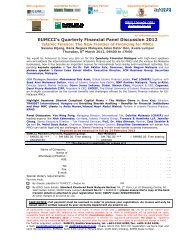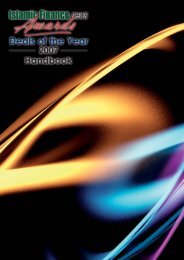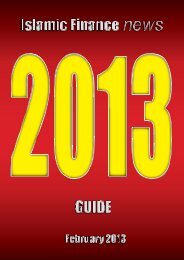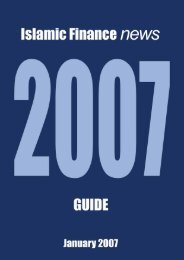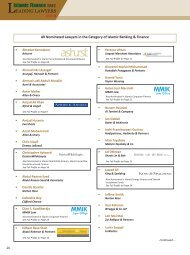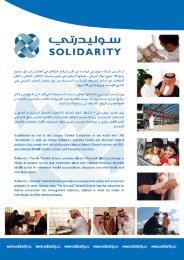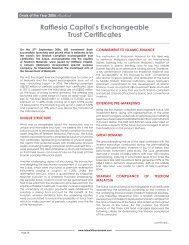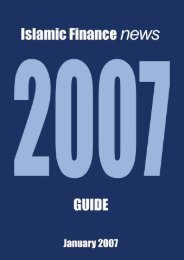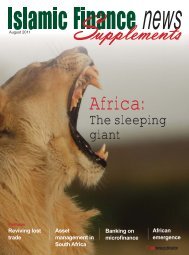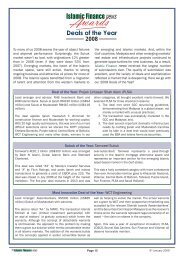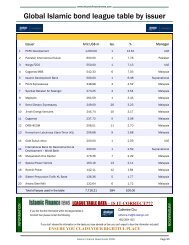legal guide09.indd - Islamic Finance News
legal guide09.indd - Islamic Finance News
legal guide09.indd - Islamic Finance News
Create successful ePaper yourself
Turn your PDF publications into a flip-book with our unique Google optimized e-Paper software.
A New Dawn For <strong>Islamic</strong> Project Financing<br />
By John Dewar<br />
The US$1.6 billion Hub River Power Project in Pakistan<br />
was the first large-scale project to include tranches<br />
of financing structured on a Shariah compliant basis.<br />
Initially, the project accessed <strong>Islamic</strong> bank finance<br />
from Al Rajhi Banking and Investment Corporation<br />
and IICG for bridge facilities prior to full financial<br />
close.<br />
These facilities were structured as Istisna and<br />
Murabahah financings and were of a relatively short<br />
tenor. In addition, the project company entered<br />
into a longer term <strong>Islamic</strong> facility with a number of<br />
Pakistani banks. At the time, <strong>Islamic</strong> project finance<br />
was heralded as a new source of funding for projects<br />
in the emerging markets.<br />
However, after the closing of Hub River in 1994, there<br />
was little, if any, activity in the <strong>Islamic</strong> project finance<br />
market. This was partly due to the fact that tenors<br />
were stretched as conventional banks found project<br />
financing more attractive (particularly projects with<br />
creditworthy long-term off-take contracts which<br />
became prevalent in the power and water sectors).<br />
<strong>Islamic</strong> banks found it difficult to match the tenors<br />
offered by conventional banks mainly because their<br />
deposit bases were significantly smaller than the<br />
major conventional banks doing business in the<br />
project financing sector.<br />
In the last few years though, there has been a<br />
significant change in the capital bases of <strong>Islamic</strong><br />
banks, particularly among Saudi Arabian and certain<br />
Far Eastern institutions.<br />
However, the growth of <strong>Islamic</strong> financing has been<br />
driven not only by a growing depositor base, but also<br />
by demand for Shariah compliant financing from<br />
corporations in the Middle East and in Far Eastern<br />
countries such as Malaysia. This has led a number<br />
of leading conventional banks to set up so-called<br />
“<strong>Islamic</strong> windows” which specialize in attracting<br />
deposits from <strong>Islamic</strong> investors and making finance<br />
available on a Shariah compliant basis.<br />
In the Middle East, the growth of <strong>Islamic</strong> finance has<br />
been particularly noticeable in Saudi Arabia where<br />
a number of large-scale project financings have<br />
included a significant <strong>Islamic</strong> finance component.<br />
A case in point is the US$3.5 billion Marafiq<br />
independent water and power project (IWPP) in<br />
Jubail, which is scheduled to reach completion in the<br />
next few months and is the largest individual power<br />
and water project in the world.<br />
“<strong>Finance</strong> documentation in the<br />
Middle East project fi nancings<br />
is governed by English law”<br />
The financing combines funding from <strong>Islamic</strong> finance<br />
institutions, international and local commercial<br />
banks and an export credit agency. This project<br />
represents a perfect example of how <strong>Islamic</strong> finance<br />
techniques have been successfully utilized in the<br />
context of multi-sourced financings, while remaining<br />
consistent with the principles of the Shariah.<br />
Customarily, <strong>Islamic</strong> financings in the kingdom<br />
have been governed by the law of Saudi Arabia and<br />
the provisions of Shariah law. Generally, finance<br />
documentation in the Middle East project financings<br />
is governed by English law (except in New York<br />
preferring Qatar).<br />
The <strong>Islamic</strong> facilities in Marafiq followed the model<br />
first developed on the Shuaibah IWPP and is based<br />
on a Wakalah-Ijarah Mawsufah Fi Al Dhimmah<br />
structure, a hybrid structure utilizing the existing<br />
and recognizable Ijarah <strong>Islamic</strong> finance technique<br />
under which a financial institution leases an asset to<br />
the customer. In the context of a project financing<br />
however, the asset needs to be built and this is where<br />
the structure must be redefined so that it remains fit<br />
for purpose while conforming to the Shariah.<br />
continued....<br />
44



